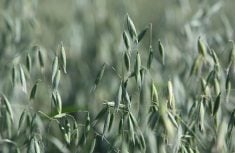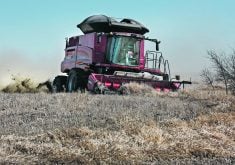With dandelions becoming an ever increasing weed problem, especially in direct seeding systems, a recently completed four-year study on the effectiveness of various fall herbicide applications has discovered that earlier is better.
Led by Ken Sapsford and Rick Holm of the University of Saskatchewan and Eric Johnson of Agriculture Canada in Scott, Sask., the study tested glyphosate, 2,4-D ester at 840 and 1,120 grams per hectare, Express, Express Pack and Spectrum.
Researchers applied herbicides in late September and late October and also tested spring-applied Amitrol 240 and glyphosate.
Read Also

VIDEO: Ag in Motion documentary launches second season
The second season of the the Western Producer’s documentary series about Ag in Motion launched Oct. 8.
“The original intent was to look at fall herbicide applications for dandelion control,” said Sapsford, a research assistant at the U of S’s Crop Development Centre.
“The first year, we looked at some late October applications. We weren’t getting the control we were hoping for, but we thought maybe by that time of the year, the dandelions are starting to shut down enough that the treatments aren’t having (enough) effect.”
The next year the researchers tried a September treatment.
“The treatments go down the last week of September and the last week of October, to compare the two. That’s when we started seeing some remarkable differences between the control we were receiving between September and October.”
Results indicated that a September treatment was far superior to an October treatment, even though they were getting some control in October. The September one was better and it seemed to last longer.
“We didn’t have (as much) regrowth, where with the October treatments, we were getting some control and leaf uptake, but we weren’t getting enough to get down and kill the entire crown of that root system on the dandelion,” Sapsford said.
“Even though it was suppressed and weakened, later on through the next year it would produce a little bit of leaf and start to regrow.”
The study found herbicides with residual activity, such as Express, Express Pack and Spectrum, were doing the best job.
“The 2,4-D, and we went with some pretty high rates of 2,4-D – the 1,120 grams active per hectare is equivalent to about 16 ounces of active 2,4-D per acre – that’s higher than you’d put in-crop, it did not a bad job,” he said.
“It wasn’t quite as sharp as the Express, Express Pack or the Spectrum, but it was still doing something for us.”
He said Spectrum was added to the trial because the researchers wanted to look at the fluorasulam portion of the chemistry.
“We started this trial prior to Pre Pass being available. If I was to look at doing this trial now, I would use Pre Pass instead of Spectrum, because that’s the product Dow is looking at for dandelion control. We’ve had some other trials with Pre Pass and I think it would be similar to the Spectrum.”
With glyphosate, Sapsford compared a fall application to a spring application, but the spring never did provide the 80 percent control that he looks for. The September treatments did an excellent job, but while October provided early control, the plants started regrowing.
The study did not try Amitrol fall-applied for dandelion control, but did try it as a spring pre-seed application.
“It gave control of dandelions early in the season. It really shut them down; they turned white, which Amitrol does. But we’re dealing with a very heavy dandelion population here, upwards of 46 plants per sq. metre, a high density of dandelions in this area.
“What we saw happen with the Amitrol was it knocked the tops off them and allowed the crops to establish, but later on in the season, they started to regrow because we did not kill that crown completely. Whether that was from the size or the number of the dandelions, we don’t have that data.”
All the treatments included a half litre of glyphosate at the 450 gram rate applied in the spring, which is a normal operation for direct seeding systems.
“Dandelions come up early in the spring, and the reason we’ve included that half-litre is, when I tried this with an October-only treatment, where I put that half-litre of glyphosate on in the spring, it did a phenomenal job of helping that fall treatment,” Sapsford said. “As far as I’m concerned, that’s a requirement. That half litre has to go on just to make it sharper.”
Researchers also wanted to look at post-harvest treatments because they didn’t want to deal with a crop canopy.
“Dandelions sit almost in a dormant-like stage while below the crop canopy. As soon as you take the crop canopy off, if it’s got some moisture and sunlight it starts to leaf out and set seed again in the fall,” he said.
“Once you’ve got some green leaves, you can go anytime in September. But the advantage, if you can go into late September, especially with products like Express, Express Pack, Pre Pass or Spectrum that has some residual characteristics, you’ll probably get some control of your winter annual weeds as well. That’s why we originally started out in October. But we found out we’re better off in September.”
Sapsford tried to look at data on how many degrees of frost it takes to shut down a dandelion, but he found it too variable from one year to the next. Instead, he chose to go with a calendar date, which isn’t as good as a frost date but seemed to work for his trials.
“The end of September, could be early October as well, depending on the year. It’ll take more than zero degrees (Celsius) to freeze a dandelion. You’ve got to get a number of nights down to the minus three to minus five. But I don’t have a handle of what that number is or how many days it is. They’re a tough plant.”
Sapsford said for a year like 2005, when crops come off and there’s moisture in the ground, dandelions are going to take off right away.
“One advantage is, with the dandelion, when you’re harvesting you’re not cutting the leaves off. It’s not like a Canada thistle. You still have all of your leaf there and it’s now exposed. You’ve got to make sure you leave it long enough so the dust from the combine operation is not still sitting there and covering it with a blanket of dust so the herbicides are not going to penetrate. You want that to clean off a bit, so give it a few weeks.”
Researchers also compared various spring versus fall applications. Sapsford said the fall application for dandelion control was always superior to a spring application, regardless of which product was applied.
However, application timing mattered when trying to control the weeds during the growing season, too.
“I did ratings six times through the growing season and you can see with just about every product, the rating gets better control in the mid-June range. That’s when the products really should be working well,” he said.
Researchers didn’t have other broadleaf weeds on the site during the trial because the dandelions were so competitive.
“So we did not come in-crop with any broadleaf herbicide. So when you look at the control, my visual ratings start to drop off after June with a number of the products. They slip down from that 80 to 90 percent control, down to 60 or 50 percent control. We’re starting another project now looking at a systems approach, because maybe if we came in at that point and gave it something in-crop that would control those dandelions as well, maybe we would have got a better control because we’d hit them with more than one product over the whole year.”
The next project will involve a systems approach, testing the economics of high, medium and low intensity systems and various timings.
“Now that we know if we’re going to spray in the fall we need to do it in September, the next step is because we know we’re not getting 100 percent, what is the best way and time to follow up the next year.”
Sapsford said producers won’t get all the dandelions even with one good application in the fall or spring. It will take a few applications of different herbicides, probably applied over a number of years.
“Even our best case scenario, which was Spectrum, Express Pack or Express in this trial where we had 98 percent control in May and June, by the end of August that was down to 80 percent control. Still good, but it shows there are a few dandelions coming back; they’ve been reseeded, or for whatever reason. So if we don’t do something within the next year or two, you know it’s going to continue to grow into a major problem once again. As we go later on, the control slowly drops off.”
Sapsford said producers are throwing a combination of mode of actions at the weed: the fall application is either a group 2 or group 4 product; the spring glyphosate application is a different mode of action and an in-crop spray might be a third type of herbicide.
“It’s not just the same thing we’re hitting them with over and over again. It’s a combination of products.”
Sapsford said the main conclusion from the study suggests that fall applications should be sprayed in late September.
“Express, Express Pack and Spectrum gave us the longest and best control, but this is just a one-time treatment and we can see it slipping off. For long-term control and management of dandelions, we’re going to have to look at a systems approach and follow up in-crop or later in the year to do a more complete control. Once you have a problem, it’s going to take more than one shot to get them.”














